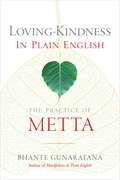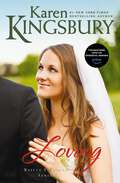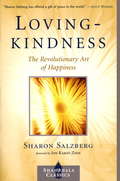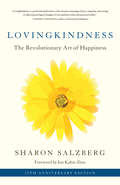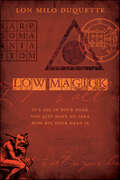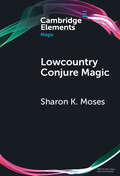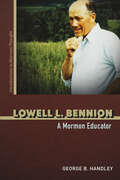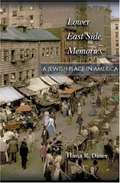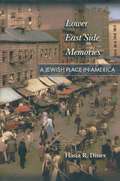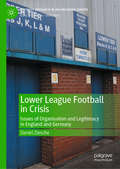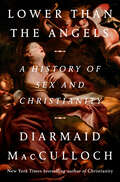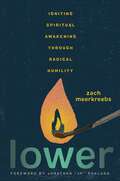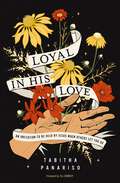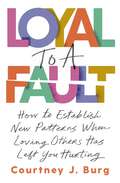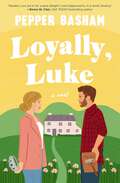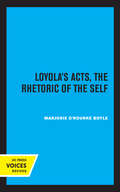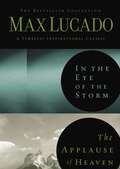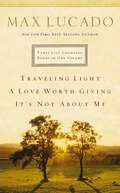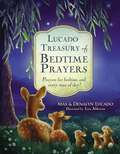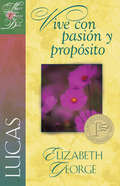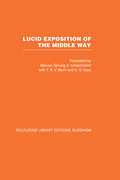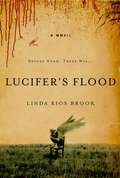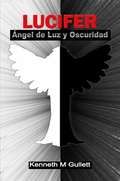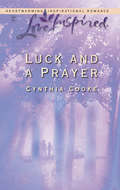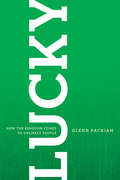- Table View
- List View
Loving-Kindness in Plain English: The Practice of Metta
by Bhante Henepola GunaratanaThe bestselling author of Mindfulness in Plain English invites us to explore the joyful benefits of living with loving-kindness.With his signature clarity and warmth, Bhante Gunaratana shares with us how we can cultivate loving-kindness to live a life of joyful harmony with others. Through personal anecdotes, step-by-step meditations, conversational renderings of the Buddha’s words in the suttas, and transformative insights into how we live in and relate to the world, we learn that peace here and now is possible—within ourselves and in all our relationships. Bhante G speaks directly to how we can cultivate loving-kindness to find emotional clarity, overcome anger, and become more peaceful—both on and off the meditation cushion.
Loving: A Love Story (The Baxters—Bailey Flanigan #No. 4)
by Karen KingsburyIn Loving, the fourth and final book in the Bailey Flanigan Series by bestselling author Karen Kingsbury, Bailey is planning her wedding . . . but did she choose her new flame or her first love?Bailey has learned much and grown over the years, but the greatest challenges, the richest joys, and the deepest heartaches are still to come. As she enjoys the beginning of her new career and time spent with Brandon, Cody faithfully coaches his team on and off the field. Torn between her feelings for both of them, she has a difficult decision to make.Has she agreed to marry the right man? Will she spend her life with Hollywood actor Brandon Paul in Los Angeles, or will her heart draw her back to small-town Bloomington, Indiana, and Cody Coleman, her first love?Features members of the popular Baxter family from New York Times bestselling author Karen Kingsbury's beloved Redemption series, now streaming onlineSweet, contemporary Christian romance The final installment of The Baxters--Bailey Flanigan seriesBook 1: LeavingBook 2: LearningBook 3: LongingBook 4: LovingIncludes discussion questions for book clubs
Lovingkindness: The Revolutionary Art of Happiness
by Sharon SalzbergThroughout our lives we long to love ourselves more deeply and find a greater sense of connection with others. Our fear of intimacy--both with others and with ourselves--creates feelings of pain and longing. But these feelings can also awaken in us the desire for freedom and the willingness to take up the spiritual path. In this inspiring book, Sharon Salzberg, one of America's leading spiritual teachers, shows us how the Buddhist path of lovingkindness can help us discover the radiant, joyful heart within each of us. This practice of lovingkindness is revolutionary because it has the power to radically change our lives, helping us cultivate true happiness in ourselves and genuine compassion for others. The Buddha described the nature of such a spiritual path as "the liberation of the heart, which is love." The author draws on simple Buddhist teachings, wisdom stories from various traditions, guided meditation practices, and her own experience from twenty-five years of practice and teaching to illustrate how each one of us can cultivate love, compassion, joy, and equanimity--the four "heavenly abodes" of traditional Buddhism.
Lovingkindness: The Revolutionary Art of Happiness (Shambhala Library #21)
by Sharon SalzbergThroughout our lives we long to love ourselves more deeply and find a greater sense of connection with others. Our fear of intimacy—both with others and with ourselves—creates feelings of pain and longing. But these feelings can awaken in us the desire for freedom and the willingness to take up the spiritual path. In this inspiring book, Sharon Salzberg, one of America's leading spiritual teachers, shows us how the Buddhist path of lovingkindness can help us discover the radiant, joyful heart within each of us. This practice of lovingkindness is revolutionary because it has the power to radically change our lives, helping us cultivate true happiness in ourselves and genuine compassion for others. The author draws on simple Buddhist teachings, wisdom stories from various traditions, guided meditation practices, and her own experience from twenty-five years of practice and teaching to illustrate how each one of us can cultivate love, compassion, joy, and equanimity.
Low Magick: It's All In Your Head ... You Just Have No Idea How Big Your Head Is
by Lon Milo DuQuetteTake a fascinating journey into the life of one of the most respected, sought-after, and renowned magicians alive today: Lon Milo DuQuette. In this follow-up to his popular autobiography, My Life with the Spirits, DuQuette tells how a friend was cursed by a well-known foreign filmmaker and how they removed that curse with a little help from Shakespeare. He explains how, as a six-year-old, he used the Law of Attraction to get a date with Linda Kaufman, the most beautiful girl in first-grade. DuQuette also reveals the ins and outs of working with demons and provides a compelling account of performing an exorcism at a private Catholic high school.As entertaining as they are informative, the true stories in this memoir contain authentic magical theory and invaluable technical information.
Lowcountry Conjure Magic: Historical Archaeology on a Plantation Slave Quarter (Elements in Magic)
by Sharon K. MosesCat Island, South Carolina, was once the location of slave trade activities, including capture of Native Americans for export and the rise of plantations in the Lowcountry for indigo and rice production, from the sixteenth to mid-nineteenth centuries. This Element examines the Hume Plantation Slave Street Project led by the author, and archaeological evidence for hoodoo magic and ritual practices involving “white magic” spells used for protection and treatments for illness and injury, and, alternately, for 'black magic,' in spells used to exact harm or to kill. This Element is intended as a contribution to the collective knowledge about hoodoo magic practices in the Lowcountry, centered on the Hume Plantation grounds during this period of American history. It is an attempt to examine how attitudes and practices may have changed over time and concludes with a look at select contemporary hoodoo activities conducted in local cemeteries.
Lowell L. Bennion: A Mormon Educator (Introductions to Mormon Thought)
by George B. HandleyThe intellectual and ethical achievements of the Latter-day Saint theologian Known in his lifetime for a tireless dedication to humanitarian causes, Lowell L. Bennion was also one of the most important theologians and ethicists to emerge in the Church of Jesus Christ of Latter-day Saints in the twentieth century. George B. Handley’s intellectual biography delves into Bennion’s thought and extraordinary intellectual life. Rejecting the idea that individual LDS practice might be at odds with lived experience, Bennion insisted the gospel favored the growth of individuals acting and living in the present. He also focused on the need for ongoing secular learning alongside religious practice and advocated for an idea of social morality that encouraged Latter-day Saints to seek out meaningful transformations of character and put their ethical commitments into practice. Handley examines Bennion’s work against the background of a changing institution that once welcomed his common-sense articulation of LDS ideas and values but became discomfited by how his thought cast doubt on the Church’s beliefs about race and other issues.
Lower East Side Memories: A Jewish Place In America
by Hasia R. DinerManhattan's Lower East Side stands for Jewish experience in America. With the possible exception of African-Americans and Harlem, no ethnic group has been so thoroughly understood and imagined through a particular chunk of space. Despite the fact that most American Jews have never set foot there--and many come from families that did not immigrate through New York much less reside on Hester or Delancey Street--the Lower East Side is firm in their collective memory. Whether they have been there or not, people reminisce about the Lower East Side as the place where life pulsated, bread tasted better, relationships were richer, tradition thrived, and passions flared. This was not always so. During the years now fondly recalled (1880-1930), the neighborhood was only occasionally called the Lower East Side. Though largely populated by Jews from Eastern Europe, it was not ethnically or even religiously homogenous. The tenements, grinding poverty, sweatshops, and packs of roaming children were considered the stuff of social work, not nostalgia and romance. To learn when and why this dark warren of pushcart-lined streets became an icon, Hasia Diner follows a wide trail of high and popular culture. She examines children's stories, novels, movies, museum exhibits, television shows, summer-camp reenactments, walking tours, consumer catalogues, and photos hung on deli walls far from Manhattan. Diner finds that it was after World War II when the Lower East Side was enshrined as the place through which Jews passed from European oppression to the promised land of America. The space became sacred at a time when Jews were simultaneously absorbing the enormity of the Holocaust and finding acceptance and opportunity in an increasingly liberal United States. Particularly after 1960, the Lower East Side gave often secularized and suburban Jews a biblical, yet distinctly American story about who they were and how they got here. Displaying the author's own fondness for the Lower East Side of story books, combined with a commitment to historical truth, Lower East Side Memories is an insightful account of one of our most famous neighborhoods and its power to shape identity.
Lower East Side Memories: A Jewish Place in America
by Hasia R. DinerManhattan's Lower East Side stands for Jewish experience in America. With the possible exception of African-Americans and Harlem, no ethnic group has been so thoroughly understood and imagined through a particular chunk of space. Despite the fact that most American Jews have never set foot there--and many come from families that did not immigrate through New York much less reside on Hester or Delancey Street--the Lower East Side is firm in their collective memory. Whether they have been there or not, people reminisce about the Lower East Side as the place where life pulsated, bread tasted better, relationships were richer, tradition thrived, and passions flared. This was not always so. During the years now fondly recalled (1880-1930), the neighborhood was only occasionally called the Lower East Side. Though largely populated by Jews from Eastern Europe, it was not ethnically or even religiously homogenous. The tenements, grinding poverty, sweatshops, and packs of roaming children were considered the stuff of social work, not nostalgia and romance. To learn when and why this dark warren of pushcart-lined streets became an icon, Hasia Diner follows a wide trail of high and popular culture. She examines children's stories, novels, movies, museum exhibits, television shows, summer-camp reenactments, walking tours, consumer catalogues, and photos hung on deli walls far from Manhattan. Diner finds that it was after World War II when the Lower East Side was enshrined as the place through which Jews passed from European oppression to the promised land of America. The space became sacred at a time when Jews were simultaneously absorbing the enormity of the Holocaust and finding acceptance and opportunity in an increasingly liberal United States. Particularly after 1960, the Lower East Side gave often secularized and suburban Jews a biblical, yet distinctly American story about who they were and how they got here. Displaying the author's own fondness for the Lower East Side of story books, combined with a commitment to historical truth, Lower East Side Memories is an insightful account of one of our most famous neighborhoods and its power to shape identity.
Lower League Football in Crisis: Issues of Organisation and Legitimacy in England and Germany (Football Research in an Enlarged Europe)
by Daniel ZiescheWhile the field of football studies has produced an abundance of literature on professional, top-league football, there is little research output to do with the non-top level football. This book explores the relationship between the top and lower leagues, laying open the drastic schisms that exist between the different levels. The study links the developments at the top level of English and German football in the past 30 years to transformational processes in lower league football. Illustrating how the hegemonic status of top football weighs hard on the spheres below, it depicts how it also serves as a blueprint for lower league football clubs’ strategies in coping with a threefold dilemma of institutional legitimacy that shows itself in economic, cultural and social dimensions. Taking the different club structures in both national contexts as a starting point, it portrays both the efficacy of institutional frameworks and how these can be challenged from below. This research will be of interest to students and scholars across football studies, sports studies, the sociology of sport, and organisation studies.
Lower than the Angels: A History of Sex and Christianity
by Diarmaid MacCulloch"An epic tale, and MacCulloch is an undaunted guide.&”—New York Review of Books A groundbreaking history of sexual emotion, sexual activity, gender relations, marriage and the family--and how Christianity has interacted with this panorama of human concernsFew matters produce more public interest and public anxiety than sex and religion. Much of the political contention and division in societies across the world centres on sexual topics, and one-third of the global population is Christian in background or outlook. The issue goes to the heart of present-day religion.This book seeks to calm fears and encourage understanding through telling a three-thousand-year-long tale of Christians encountering sex, gender, and the family. The message of Lower than the Angels is simple, necessary and timely: to pay attention to the complexity and contradictions in the history of Christianity. The reader can decide from the story told here whether there is a single Christian theology of sex, or many contending voices in a symphony that is not at all complete. Oxford&’s Emeritus Professor of the History of the Church introduces an epic of ordinary and extraordinary Christians trying to make sense of themselves and of humanity&’s deepest desires, fears and hopes.
Lower: Igniting Spiritual Awakening Through Radical Humility
by Zach MeerkreebsIn this inspiring account, a pastor shares how radical humility ignited a sixteen-day revival on a small college campus—and why it is an essential tool for building a closer relationship with God. As Zach Meerkreebs ended his sermon on the campus of Asbury University, he challenged, &“Do not leave here until you experience the love of God so that you can pour it out.&” Several students remained, praying and worshipping, and others joined them until a crowd formed that grew to over 65,000 and covered the campus and small Kentucky town. As the worshipping and praying continued, for sixteen days and nights, the media began reporting on what came to be called the Asbury Outpouring. In Lower, Zach shares his experiences at the Outpouring and answers his own question, what sparked this revival? With personal stories, Scripture, testimonies from Asbury, wisdom from other Christian writers, and key insights he has received in quiet moments with Jesus, Zach shows readers the path to radical humility and deeper friendship with God. As we go lower in our pursuit of humility, we can steward spaces prepared for a move of God and shine Jesus to all those who are watching.
Loyal in His Love: An Invitation to Be Held by Jesus When Others Let You Go
by Tabitha PanarisoWhen everyone else leaves, Jesus stays. When all fails, Jesus remains.Rejection is inevitable. Yet we spend little time considering the significant impact it makes on an individual's whole self. When we do, we swaddle it in quippy statements and shallow encouragement--meaningful for just a moment. But rejection--like abandonment, betrayal, and estrangement--leaves aching wounds that challenge and forge our most intimate thoughts of who we believe God, others, and ourselves to be.In Loyal in His Love, Tabitha Panariso blends biblical truth, candid personal stories, and timeless wisdom forged through personal experience and her vocation as a therapist to invite readers into a new way of living. The heart that suffers rejection can't be cured. It must be resuscitated. Its condition warrants more than just platitudes--it merits the full attention of a loyal and loving God.This isn't just another Christian self-help book. Though Tabitha makes ample room for the hurting to process their own stories, points them to God's faithfulness, and challenges the way they think--she doesn't stop there. Jesus lived a life and death marked by rejection. Yet we remember Him for His compassion and generosity. He was and is proof that we could be remembered that way too. Thus, Tabitha guides readers through the life and death of Jesus as a means of counter-cultural response to the pain of rejection.Loyal in His Love ends squarely on the triumph of Christ's resurrection--not just as an antidote but a daily supplement. His restoration is ours--alive and active in our hearts, bodies, and lives. Each devastating moment of rejection is an opportunity to build bridges that will lead us into and through living hope and transformation.
Loyal to a Fault: How to Establish New Patterns When Loving Others Has Left You Hurting
by Courtney J. BurgDo you find yourself living as the people pleaser or peacekeeper? Do you avoid conflict? Learn how to overcome your fears about setting boundaries and step into a life that's overflowing with love, respect, and healthy relationships.We are people who love patterns, even if returning to these patterns continues to hurt us or those we love. Some of the most harmful patterns of behavior are passed down through generations and inherited, often without our permission or awareness. The conflict arises when these behaviors are so deeply woven into early family systems that they later become part of our identities, clashing with who God has created and called us to be.As a child, Courtney Burg quickly learned that remaining loyal to others meant keeping secrets, even if these secrets were keeping those she cared for most sick. Her efforts to sustain the peace followed her into adulthood and slowly left her depleted, discouraged, and drowning in the chaos—until Courtney discovered that not only did God grant her permission to engage in relationships differently, but that he gave her specific instruction on how to do so.In Loyal to a Fault, Courtney Burg unpacks the various ways we cope with, enable, and participate in unhealthy relationships or generational trauma. Using personal examples and providing practical wisdom, Courtney helps you break free from codependent patterns by:Identifying the role you are playing in keeping the dysfunctional patterns going.Reframing what it means to love and remain loyal to those who matter most.Reminding you that boundary work is a biblical practice.Including end-of-chapter prompts for deeper introspection. It is possible to learn how to love others well without losing yourself along the way. People pleasing, complaining, and exhaustion may be today's norm, but at any moment you can choose to do things differently. Begin setting boundaries and start enjoying relationships in all the ways God designed you to.
Loyally, Luke
by Pepper BashamSometimes love means embracing the good, the bad . . . and even the impossible.Dear Reader,My name is Luke Edgewood, and there are few things in life that I require. Mainly black coffee. And flannel. And lots of solitude. And my dogs, Chewy and Indie. What I don&’t need is romance, so I have no plans to change my thirty-year-old bachelor status anytime soon.But my youngest sister thinks that by accepting a short-term construction job in the small European country of Skymar, I&’m going to follow along in her footsteps and discover my own romantic adventure. Nope. Bah humbug. The End. This time, her rom-com-movie senses are totally wrong.Or maybe not. Because I&’ve met a Grace Kelly look-alike who is annoying . . . until she isn&’t. But she is impossible. As in, nothing can happen between us because she is a literal princess. Even though that&’s easy to forget when we&’re working together to restore a castle-like orphanage in a secluded mountain town and &“forced proximity&” includes a small closet, a secret one-hundred-year-old journal, and the tactile memory of an off-limits royal in my arms.Basically, the whole situation has turned into an ooey gooey magical snow globe of romantic tropes complete with cute kids and an actual ball. Now, even my sentences are starting to sound like mush. Ugh. Send high levels of testosterone my way—I&’m going to need it.Loyally,Luke&“Readers, you are in for a pure delight! Luke Edgewood is, in a word, dreamy.&”—Emma St. Clair, USA TODAY bestselling authorWitty, hilarious, and heartwarming contemporary romanceA sweet, kisses-only romanceStand-alone novelBook length: approximately 107,000 wordsIncludes discussion questions for book clubs
Loyola's Acts: The Rhetoric of the Self (The New Historicism: Studies in Cultural Poetics #36)
by Marjorie O'Rourke BoyleThis title is part of UC Press's Voices Revived program, which commemorates University of California Press’s mission to seek out and cultivate the brightest minds and give them voice, reach, and impact. Drawing on a backlist dating to 1893, Voices Revived makes high-quality, peer-reviewed scholarship accessible once again using print-on-demand technology. This title was originally published in 1997.
Lucado 2in1: (Traveling Light & The Great House of God)
by Max LucadoTraveling Light: Weary travelers. You've seen them-everything they own crammed into their luggage. Staggering through terminals and hotel lobbies with overstuffed suitcases, trunks, duffels, and backpacks. Backs ache. Feet burn. Eyelids droop. We've all seen people like that. At times, we are people like that-if not with our physical luggage, then at least with our spiritual load. We all lug loads we were never intended to carry. Fear. Worry. Discontent. No wonder we get so weary. We're worn out from carrying that excess baggage. Wouldn't it be nice to lose some of those bags? That's the invitation of Max Lucado. With the Twenty-third Psalm as our guide, let's release some of the burdens we were never intended to bear. The Great House of God: God's greatest desire is to be your dwelling place. Using the Lord's Prayer as a floor plan for The Great House of God, Max Lucado introduces us to a God who desires his children to draw close to him. Warm your heart by the fire in the living room. Nourish your spirit in the kitchen. Step into the hallway and find forgiveness. No house is more complete, no foundation is more solid. So come into the house built just for you-The Great House of God.
Lucado 3-in-1: Traveling Light, Not About Me, Love Worth Giving
by Max LucadoThis 3 in 1 bundle is a great value from best-selling author Max Lucado. Titles included in this bundle are "Traveling Light", "It's Not About Me", and "A Love Worth Giving".
Lucado Treasury of Bedtime Prayers: Prayers for bedtime and every time of day!
by Max LucadoThis collection of classic prayers, as well as brand-new prayers by Max and Denalyn Lucado, will help parents who want to make prayer a daily part of their children&’s lives.Prayer is the foundation of a believer&’s life. This collection of prayers from Max and Denalyn Lucado offers parents a resource to teach little ones how to talk to God. This prayer collection includes classic prayers that have been updated for today&’s young readers, introductory stories for each section, as well as twenty new prayers for little ones written by Max and Denalyn.Max and Denalyn open the book with an expanded introduction that instructs parents on teaching their children to pray. A helpful prayer builder taken from Max&’s trade book Before Amen teaches kids that there are four different kinds of prayers: worship, trust, compassion, and gratitude. This collection of new and classic children&’s prayers are divided into ten sections. Children will find it easier to learn to pray with examples showing that prayer is a dialogue with God for all times. Beautiful art by Lisa Alderson complements the keepsake style of the book. It&’s never too early to lay a strong foundation for a child&’s faith, and the Lucado Treasury of Bedtime Prayers will help parents do just that.
Lucas: Vive con pasion y proposito
by Elizabeth GeorgeCentrándose en las enseñanzas de Jesús y los principios que regían en su vida, este estudio del libro de Lucas ayuda a las mujeres a conocer a Jesús más íntimamente. Los estudios incluyen: * las vidas de mujeres del Nuevo Testamento que conocieron y sirvieron a Jesús * la pasión y el propósito de la vida de Jesús * la poderosa vida de oración de Jesús * la actitud de servicio practicado por Jesús * las profecías acerca de Jesús y cómo se cumplieron Con aliento sutil y enseñanza claramente bíblica, Vive con pasión y propósito revela cómo llegar a ser más como Jesús en la vida cotidiana y compartir gozosamente el evangelio con otros. Un libro excelente para el estudio bíblico personal o en grupos pequeños. Focusing on Jesus' teachings and the principles He lived by, this study of the book of Luke helps women know Him more intimately. Readers will explore- * the lives of New Testament women who knew and ministered to Jesus * the passion and purpose of Jesus' life * the powerful prayer life of Jesus * the servanthood practiced by Jesus * the prophecies regarding Jesus and how He fulfilled them With gentle encouragement and solid Bible teaching, Living Life with Passion and Purpose reveals how readers can become more like Jesus in their daily lives and joyfully share the gospel. Excellent for group and individual study.
Lucid Exposition of the Middle Way: The Essential Chapters From The Prasannapada of Candrakirti (Routledge Library Editions: Buddhism)
by Mervyn SprungOriginally published in 1979. The Prasannapada is the explanation of the versed aphorisms of Nagarjuna which are the first and basic statement of the Buddhist philosophy of the middle way. When first published, this volume was the first attempt, in any European language, to present all the essentials of this most radical of Buddhist philosophical works. Seventeen of its twenty-seven chapters have been chosen to give an integrated statement of every aspect of its arguments and conclusions.
Lucifer's Flood: A Novel (The Reluctant Demon Diaries #1)
by Linda Rios Brook“The sensation of falling was terrifying…we tumbled out of the realm of the heavenly light into perpetual darkness. We had not seen darkness before--not like this anyway... A strange man shows up at the office of language expert Samantha Yale with a mysterious scroll written in an even more mysterious language. As she begins to translate, she discovers an eyewitness account of the war in heaven from an angel who sided with Lucifer and then deeply regretted his decision. The tale is hard to believe... but impossible to ignore. Linda Rios Brook brings new depth of imagery into the spirit world and scholarship to the old debate, “What happened to the world between Genesis 1:1 and 1:2?” Part intriguing theological exploration, part swashbuckling adventure, Lucifer’s Flood presents an equally fascinating and frightening tale of prehistoric heaven and Earth.
Lucifer, ángel de luz y oscuridad.
by Kenneth GullettEl nombre de Lucifer solo se haya mencionado una vez en toda la Escritura, y sin embargo sigue siendo considerado como la influencia maligna más poderosa del mundo. Así ha sido desde los tiempos de Adán y Eva hasta nuestros días, y así permanecerá hasta que el Juicio Final se derrame sobre la tierra. ¿Cual es la meta final de Lucifer? ¿Como podemos enfrentar a un adversario tan temible, cuando incluso los ángeles con su fuerza sobrenatural, no se atreven a cuestionar? Sin embargo, dado que la Biblia nos advierte que Lucifer es el dios de este mundo, podemos preguntarnos ¿qué clase de mercancía usará para tentarnos al pecado? Las Escrituras son claras en su descripción, sobre quién es y que busca. Siendo los seres falibles que somos, ¿como podemos resistir las tentaciones malignas que buscan apartarnos del verdadero Dios de los cielos, quien es el Creador de todas las cosas? Es Dios quien separó la luz de la oscuridad, según el capítulo primero del Génesis, y es quien también separó el bien del mal por medio de su Palabra Viva, Jesucristo. Por lo mismo es en el quien ponemos nuestras esperanzas de salvación, no en Lucifer ni en nosotros mismos. Este trabajo pretende revelar quien realmente es Lucifer, nuestro gran adversario, sus atributos, sus mercancías y sus metas. Pero sobre todo, este trabajo pretende revelar quien es el rey de Reyes y Señor de Señores.
Luck and a Prayer
by Cynthia CookeAs a tough L.A. cop, Willa Barrett thought she could handle anything. Until she was trekking through mountainous woods, trying to find evidence that was mixed up with a youth minister leading a preteen church retreat.Willa soon discovered the forest' s dangers weren' t anything like the ones she usually faced, and she needed help-- pronto. Luckily handsome youth minister Jeff MacPhearson knew the woods inside out. Or was it something more than luck? Willa had never pictured any man entering her life-- let alone saving it. But suddenly there was no way out without the help of this caring minister, who had the kindest eyes she' d ever seen....
Lucky
by Glenn PackiamLucky uncovers how the poor, hungry, mourning and persecuted are blessed because the Kingdom of heaven--its fullness, comfort, and reward--is theirs in spite of their condition. This is Christ's announcement: the Kingdom of God has come to unlikely people. Like the people Jesus addressed, we are called lucky not because of our pain or brokenness but because in spite of it, we have been invited into the Kingdom. The trajectory of our lives have been altered. What's more, we now have a part in the future that God is bringing. Like Abraham, we have been blessed to carry blessing, to live as luck-bearers to the unlikely and unlucky.
